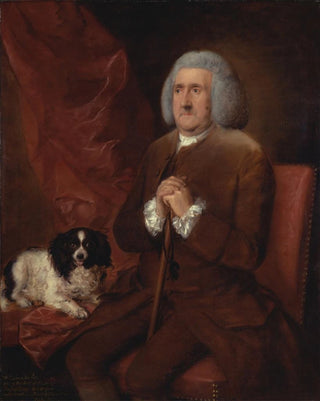Art print | William Lowndes, auditor of Her Majesty's Exchequer Court - Thomas Gainsborough


View from behind

Frame (optional)
William Lowndes, auditor of Her Majesty's Court of the Chancery - Thomas Gainsborough – Captivating Introduction
Thomas Gainsborough's artwork, "William Lowndes, auditor of Her Majesty's Court of the Chancery," stands as a vivid testament to the elegance and sophistication of 18th-century Britain. In this painting, the artist masterfully captures not only the face of a man of power but also the essence of an era marked by political and social upheavals. The depiction of Lowndes, both stoic and full of character, evokes an almost palpable curiosity in the viewer, inviting reflection on this man's life and the surrounding context. Gainsborough, a master of portraiture, manages to infuse a psychological depth into his subject, transforming a simple portrait into an open window onto a bygone era.
Style and uniqueness of the work
What makes this piece so distinctive is how Gainsborough blends realism with an almost romantic approach to portraiture. The meticulous details of Lowndes's costume, with its rich textures and subtle colors, testify to exceptional craftsmanship. Light plays a crucial role in this composition, illuminating the subject's face while creating delicate shadows that add an almost sculptural dimension to his appearance. The background, with its soft and harmonious tone, highlights Lowndes's silhouette while contributing to the overall atmosphere of dignity and serenity. Gainsborough also employs fluid brush techniques, which give an impression of movement and life, making the portrait not only static but vibrant.
The artist and his influence
Thomas Gainsborough, an iconic figure of English painting, established himself as an innovator in the field of portraiture. By breaking free from the rigid conventions of his time, he paved the way for a new artistic approach where emotion and personality took precedence over mere social attributes. His ability to capture the nuances of the human soul, along with his interest in nature and landscape, influenced many artists who followed in his footsteps. Gainsborough also was

Matte finish

View from behind

Frame (optional)
William Lowndes, auditor of Her Majesty's Court of the Chancery - Thomas Gainsborough – Captivating Introduction
Thomas Gainsborough's artwork, "William Lowndes, auditor of Her Majesty's Court of the Chancery," stands as a vivid testament to the elegance and sophistication of 18th-century Britain. In this painting, the artist masterfully captures not only the face of a man of power but also the essence of an era marked by political and social upheavals. The depiction of Lowndes, both stoic and full of character, evokes an almost palpable curiosity in the viewer, inviting reflection on this man's life and the surrounding context. Gainsborough, a master of portraiture, manages to infuse a psychological depth into his subject, transforming a simple portrait into an open window onto a bygone era.
Style and uniqueness of the work
What makes this piece so distinctive is how Gainsborough blends realism with an almost romantic approach to portraiture. The meticulous details of Lowndes's costume, with its rich textures and subtle colors, testify to exceptional craftsmanship. Light plays a crucial role in this composition, illuminating the subject's face while creating delicate shadows that add an almost sculptural dimension to his appearance. The background, with its soft and harmonious tone, highlights Lowndes's silhouette while contributing to the overall atmosphere of dignity and serenity. Gainsborough also employs fluid brush techniques, which give an impression of movement and life, making the portrait not only static but vibrant.
The artist and his influence
Thomas Gainsborough, an iconic figure of English painting, established himself as an innovator in the field of portraiture. By breaking free from the rigid conventions of his time, he paved the way for a new artistic approach where emotion and personality took precedence over mere social attributes. His ability to capture the nuances of the human soul, along with his interest in nature and landscape, influenced many artists who followed in his footsteps. Gainsborough also was






